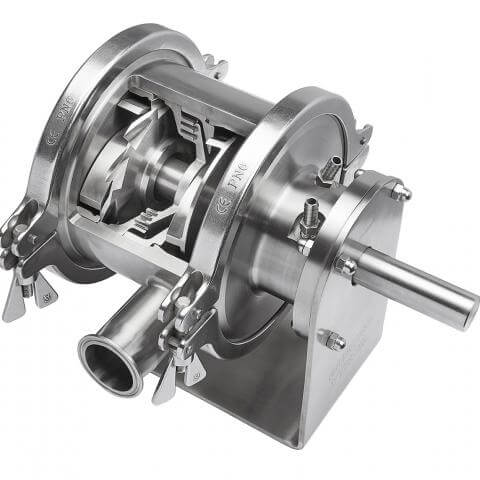The Quadro® HV-Emulsifier and Wet Mill, is an advanced high-shear mixing device designed for creating submicron emulsions and performing suspension micronisation. We’ll be taking a look at some key points about the HV emulsifier and Wet Mill and how it compares to more conventional in-line High Shear Mixers such as the Quadro Z Emulsifier..
Key Features of the HV Emulsifier & Wet Mill
The HV series offers significantly more shear energy generated from operation at tip speeds, coupled with tight rotor-stator gaps unlike any other conventional rotor-stator mill, making them highly effective for submicron homogenising and wet milling. These emulsifiers are versatile and can function as both homogenisers and wet mills, reducing capital costs compared to high-pressure homogenisers or media mills. They are also designed with unmatched sanitary features, including fully drainable designs and quick-connect sanitary clamps for easy removal and cleaning. The HV Series comes equipped with a double mechanical seal design that utilizes a flow switch to ensure proper lubrication of the seal is present at all times when the unit is in operation protecting the seal from premature failures.
Applications of HV Emulsifier
HV emulsifiers have a wide range of applications. They are ideal for drug suspensions, API milling, and topical formulations in the pharmaceutical industry. In the food and beverage industry, they are used for creating stable emulsions and particle size reduction in functional foods and beverages to improve textures and mouth feel. In the cosmetics and personal care industries, they excel in emulsifying products such as creams and lotions as well as reducing particle size or eliminating agglomerations of materials in suspension. They are also effective for applications like wood staining and agricultural products in the chemical industry. No matter the industry, the HV is a viable solution for a variety of application needs when it comes to emulsions or particle size reduction.
Pros of HV Emulsifier
HV Emulsifiers offer several benefits. They are able to achieve submicron emulsions without the need for subsequent processing, lowering overall costs. These emulsifiers can also reduce batch times and maximise raw ingredient utilisation. The units are designed to offer precise process scaling from lab formulation to pilot and production processing Relative to high pressure homogenizers they offer a lower initial capital cost as well as lower maintenance costs..
Cons of HV Emulsifier
Now, let’s discuss in-line emulsifier mixers, but first understand some differences between the two.
Differences Between the HV Conventional In-Line Emulsifier Mixers
The HV is designed to operate at tip speeds up to 70 m/s which results in extremely high shear energy input, making them ideal for creating submicron emulsions and performing suspension micronisation. These units are versatile and can function as both homogenisers and wet mills, making them suitable for a wide range of applications in pharmaceuticals, food and beverages, cosmetics, and chemicals.
Conventional In-line emulsifier mixers will typically operate at maximum tip speeds of 25 m/s.. They generally provide lower shear compared to HV emulsifiers, making them suitable for less demanding emulsification tasks. In-line emulsifier mixers are often used in food processing, cosmetics, and chemical industries.
HV emulsifiers provide higher shear energy compared to in-line mixers.
Z Emulsifiers
The Quadro Ytron® Z Inline Emulsifier series, are
high-shear mixers designed for efficient emulsification, homogenisation, wet grinding, deagglomeration, and fine solids dispersing. They feature multiple stages (1-3 stages) of sequential rotor-stator mixer tooling, which operate at high differential velocities with numerous shear zones. The emulsifier is designed with sanitary features, including clamped housings for easy cleaning and optional Clean-In-Place (CIP) executions.
Available in various slot sizes, the emulsifier allows for fine-tuning of the process. Z emulsifiers are used in pharmaceuticals, food and beverage, cosmetics, and chemicals. They offer improved performance, increased capacity, enhanced product quality, cleanability, and process flexibility.
Conclusion
When choosing between the HV and a conventional in-line mixers, it’s essential to consider your specific application requirements. HV emulsifiers are ideal for demanding tasks that require high shear energy, such as submicron emulsification and suspension micronisation. Ultimately, the best choice of technology depends on many factors such as the desired level of emulsification, processing requirements, and available budget.
